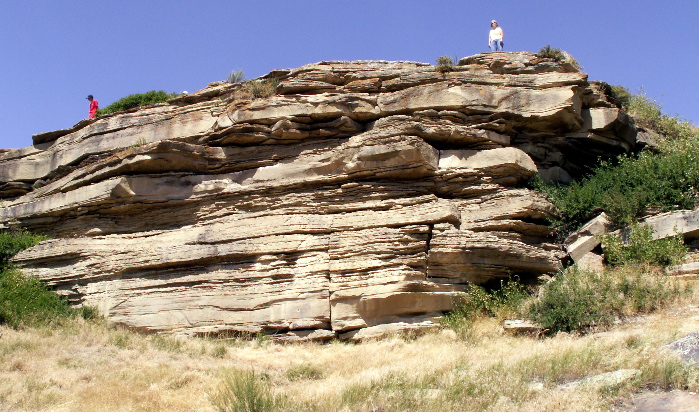|
Radiocarbon Dating Helps Archaeologists Understand First Montanans
 Above: Here is a small portion of the extensive cliffs at First Peoples Buffalo Jump near Great Falls (formerly called Ulm Pishkun). The cliff area is about 1500 meters long (almost 1 mile).
We know that ancestors of Native Americans were the first people to inhabit Montana, and we have a fair understanding of which tribes lived here, and how they lived over the past 150-200 years. White settlers, explorers, soldiers, and journalists wrote about this era, and oral accounts were passed down over generations among Indian people. However, to learn about the heritage of Montana's tribes centuries farther back in time is much more challenging because experts have to rely on types of evidence that are harder to find and more difficult to interpret.
Mother Lodes . . .
Stories, artifacts, trails, tipi rings, and rock art all offer glimpses into the lives of pre-historic Native American cultures. Another tremendous source of evidence are the numerous bison kill sites scattered throughout the region. Archaeologists have identified over 300 in Montana alone, and there are likely many more that haven't been found or reported. We know them as "buffalo jumps," however most are not cliffs, but rather places where bison were driven into natural or man-made enclosures, or into bogs or snow-banks, and then finished off with weapons. No two are exactly the same, but they often contain a wealth of evidence, including bison bones, arrowheads, tools, roasting pits, and fire-cracked rock. Below: This diorama depicts the First Peoples Buffalo Jump. (Courtesy of Montana Historical Society)  What's the point? . . .
What's the point? . . .
Two important questions archaeologists try to answer as they unearth a kill site are, "Who used this place?" and "During what span of time did they use it?" Arrowheads and spear tips, called "points," can help provide an answer to the first question. Archeologists have learned to recognize trademarks and differences between points designed by various Indian tribes and Paleoindian groups. For example, experts know that the Wahkpa Chu'gn kill site in Havre was first used by the Besant people because the bottom layer of bones contains spear points fashioned in a style unique to that culture. The Besant used a spear-like weapon called an "atlatl", whereas the Avonlea and Saddle Butte peoples, who used the site during later times, preferred the bow and arrow. At another kill site in south-central Montana one layer of bones contains arrowheads crafted by Shoshone Indians, revealing that this has not always been Crow territory.
The Carbon-14 clock . . .
To determine when a certain tribe used a kill site, archaeologists rely on radiocarbon dating (a.k.a carbon dating). Radiocarbon dating is a type of radiometric dating that is especially useful at kill sites because it can be used to date organic materials; materials that were once part of a living things (flesh, bone, wood, charcoal, seeds, etc.). Because of its relatively short half-life, the radiocarbon technique is useful only for dating things that lived within the past 50,000 years. Although carbon dating cannot be used to establish the age of points, it can be used to date organic materials found in the same layer as the points. Where bone layers haven't been disturbed it is presumed that the points are the same age as the bones they lie with.
How it works . . .
A small amount (.0000000001%) of all carbon atoms are a radioactive isotope known as Carbon-14. As years go by, these C-14 atoms gradually undergo radioactive decay, changing into Nitrogen-14 atoms. Scientists know that it takes 5,730 years for half of the C-14 to change into N-14. This length of time is called the "half-life.' If scientists find that a bone has a C-14 to N-14 ratio of 1 to1, they would conclude that the organism died approximately 5,730 years ago. If the ratio is 1:3, then two half-lives have gone by . . . the bone is about 11,500 years old.
Confused? . . . Watch this 9-minute Youtube video.
According to Dr. Jack Fisher of Montana State University, the organic materials used to establish dates at the First Peoples site were wood charcoal (burnt wood from a campfire) and blowfly pupae cases. A mass of hundreds (or thousands) of blowfly pupae were found with the bones of a bison forelimb that may have been discarded with muscle tissue still present. The samples of charcoal and pupae were sent to a lab at the University of
Arizona to be radiocarbon dated.
Along came the horse . . .
Radiocarbon dating of organic materials from the First Peoples Buffalo Jump revealed that it was used from about 900 AD until at least 1500 AD. The styles of points found there match those from the pre-historic Avonlea and Old Women's cultures (ancestors of more recent Indian tribes). Archaeologists aren't sure exactly when Indians stopped using the First Peoples Buffalo Jump because the upper layers of bones have never been carbon dated. However, they do note that the use of buffalo jumps generally started to decline in the 1700s with the arrival of the horse . . . an animal that brought many big changes to the Indian way of life.
Terms: Paleoindian, organic, isotope
|


